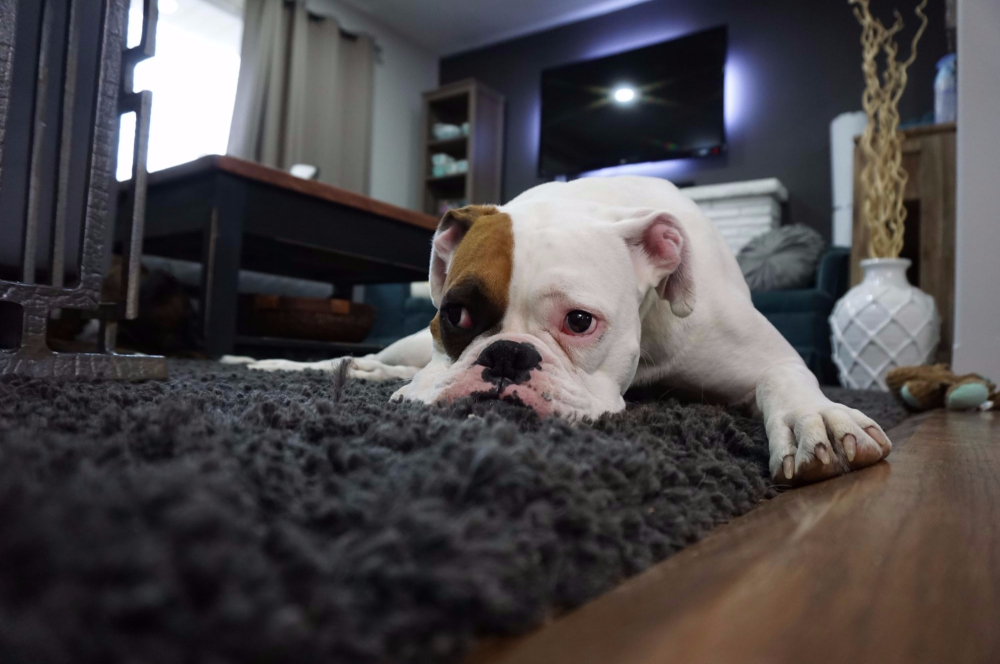What’s cuter than a roly-poly fat puppy? You’re probably struggling to name something sweeter than that but can’t.
Fat puppies are lovely, and because they’re so cute, it’s hard to look at them and wonder if they’re healthy. After all, all babies are chunky, right? Well, there’s a difference between baby fat and obesity, and recognizing the difference early is the key to ensuring your dog grows out of their chubby stage and into a healthy adult dog.
For all of those who wonder, “is my puppy too fat,” here’s what you need to know about your portly puppy.
Growing Up Healthy: Puppy Development Stages
Different breeds grow at different stages, so it’s impossible to provide a general height and weight chart for puppies. Check with your vet to see how your breed should progress. However, it is possible to provide a general timeline for the growth of your puppy.
Week 1-6
During the first week after your puppy is born, healthy growth should result in your puppy doubling their birth weight.
By two weeks old, your puppy should start growing rapidly and add 5 to 10% of his body weight every day.
After six weeks, their growth starts to slow and is dramatically affected by their breed.
6 weeks to 6 months
If your puppy is a small breed, they may gain somewhere in the range of 5 ounces every week. Bigger breeds have further to go and will add 2.5 pounds per week.
6 months to 18 months
After six months, their growth starts to level off. For small dogs, their weight may not change significantly between 12 and 18 months. Large dogs will see the steepest weight gain and could grow from 50 kilograms in weight to 70 kilograms within the space of six months.
These figures represent normal weight gain among common breeds. But it’s best to read up on your dog’s breed to see how they’ll progress.
Why Do Puppies Get Fat?
A certain amount of fluff and fat is common among puppies. Fat pugs and fat bulldog puppies are evidence of how cute (and normal) a few rolls can be. But dogs today face setbacks that don’t jive with their natural growth.
And ultimately, the reason puppies go from cute and chubby to fat is down to you. Diet and exercise are important throughout a dog’s life, but they’re critical during their puppy stage. Dogs who enjoy food that’s high in fat or calories and live indoors all day are more likely to get fat.
They may eat more because they’re bored or overfed. Their food may not be the right type for their breed. And puppy treats, which aren’t subject to regulations, may include high amounts of carbs, fats, and calories that cause your pup to pack on the pounds.
Is My Puppy Fat?
Because dogs change so much during their first 18 months of life, many owners struggle to tell the difference between weight gain and borderline obesity.
Moreover, their weight on the scale also isn’t an indicator of how fat they are, particularly among more muscular breeds.
Understanding the role of the scale in measuring puppy obesity is similar to understanding healthy weight in humans. For humans, the weight on a scale is just a number. Most elite athletes may show up as obese because of the sheer amount of muscle they carry. This is why doctors use the Body Mass Index, which tells you how much of your mass is muscle and how much is body fat.
A similar tool has been developed for canines – it’s called the body condition score (BCS).
The BCS was developed by the scientists at Purina — the dog food manufacturer — as a way of determining whether your dog is getting enough food. Essentially, it’s a tool that is better able to tell you whether you’ve got a muscular pit bull or a fat pit bull.
Using the BCS doesn’t mean putting your dog in a Bod Pod or a float tank. It’s a simple measurement designed for you to use at home. The BCS is a visual assessment of your dog’a muscle and fat. Essentially, you’ll look at where your dog carries their weight and use your hands to confirm.
To get started, you’ll need a chart. You can ask your vet for their preferred version or use a chart from an online resource. The charts may look like this one below, for pugs:
Here is the new and amended Body Conditioning Score Chart for pugs.
Posted by Pug Dog Welfare and Rescue Association UK on Wednesday, November 22, 2017
The chart serves as a guide and while many are similar, some may be more detailed than others.
How to Assess Your Dog’s Weight
To use the chart, you’ll start by feeling your dog’s ribs.
Place your hands over their rib cage and press gently. In a healthy dog, you’ll be able to individual ribs without too much pressure. In an underweight dog, you’ll feel them right away. You’ll struggle to find them at all in overweight dogs. Health dogs shouldn’t carry fat over their ribs, but you also shouldn’t be able to see the individual ribs either.
Next, you’ll carefully feel your dog’s abdomen.
Their abdomen should present an hourglass shape; there should be a tuck going from their waist down along their back. If your dog is too think, their bones will be easily felt. You’ll often find their shoulder blades, ribs, and hip bones will stick out. If the dog is overweight, you’ll find it difficult to feel these bones without pressing too hard.
You can print a better copy here https://www.dogfoodadvisor.com/wp-content/uploads/2016/03/Purina-Body-Condition-Score-Diagram.pdf
Posted by Stacy Germany on Sunday, November 26, 2017
When you’re done, you should be able to tell which of the three body categories your puppy falls into:
Underfed
- Visible ribs and other bones
Ideal
- Can feel bones with palpating
- Belly is “tucked” when you look at them side on
Overfed
- Lack of “tucked” waist
- Round belly
- Unable to feel ribs or other bones
How to Help Your Fat Puppy
It’s tempting to assume your puppy will grow out of his baby fat. But the reality is that not only may he grow up to be an overweight adult dog, but it increases your puppy’s risk of disease in adulthood. Helping your fat puppy lose weight now is essential for a long, happy life. Your puppy’s weight depends on the same factors yours does: diet and exercise.
Diet
To start, ensure that your puppy is getting the appropriate amount of food at meal times. You should be measuring their servings to make sure they’re getting the right amount of calories at mealtime.
Sometimes the macronutrients in your puppy’s food play a role in weight management. Feeding them a high-protein meal may cause additional weight gain. Too many carbs may also result in bulking.
Ideally, you’ll be able to find a “complete and balanced” brand of dog food that is made up of 30-70 percent carbs, 20-25 percent protein, and up to 15 percent fat.
However, it doesn’t hurt to tailor your dog’s food to their breed or their age.
Additionally, you’ll need to stop supplementing their diet with additional treats or table scraps. Stick to the 10 percent rule to ensure you’re not thwarting your own best efforts by over-treating them.
If you’re not sure what dog food is best suited for your pup, ask your vet.
Exercise
Dogs need exercise to be happy and healthy.
The ideal amount of exercise should include two 30-minute walks per day.
But some breeds need more exercise than this – and if they don’t get it, you’ll be able to tell. They may either use their puppy energy to destroy your house or gain weight (or both).
Finding other ways to exercise is also helpful for dogs.
Playtime with you is a fun way to bond with your dog and help them get the exercise they need.
Dog parks are also an easy way to supplement exercise. Finding a local dog park serves two purposes: it promotes exercise and helps socialize your dog during those critical adolescent years.
If you don’t have the time, energy, or ability to help your dog exercise, consider sending your pup to doggy daycare or hiring a dog walking service.
Exercise is a non-negotiable part of owning a dog. If you can’t help them exercise on your own and don’t have any means of allowing them to exercise, you will struggle to help them be happy and healthy.
Losing Weight the Healthy Way
Diet and exercise are the keys to maintaining a healthy weight. If you give your dog both, you’ll find they will lose about two percent of his body fat every week until he reaches a natural, maintenance weight.
If you’re giving him both and the weight isn’t shifting, it may be time to visit the vet. A veterinarian can evaluate your weight loss program and tailor it specifically to your dog.
Additionally, they’ll be able to determine whether your dog’s weight is the result of hypothyroidism. Hypothyroidism is found in any breed, but it’s most common in golden retrievers, Irish setters, cocker spaniels, Doberman pinchers, and dachshunds.
Don’t be tempted to help your dog lose weight quickly. Just as in humans, crash diets and too much exercise are bad for your dog.
Stick to a healthy diet and a basic exercise routine, and you’ll set your pal up for a long, healthy life.
Help Your Fat Puppy Become a Healthy Adult
Fat puppies are cute, but there’s a difference between baby fat and obesity.
Helping your pet maintain a healthy weight is part of being a responsible dog owner, and you’re a key part of their health.
Remember, if you have questions about the best practices for maintaining your dog’s health, your first port of call should be your trusted veterinarian. They’ll have the most resources for helping your individual dog.
Have you had to help your pup lose weight? How did you work through feeding and exercise changes? Share your stories in the comments below.






